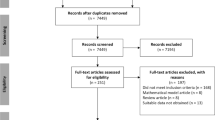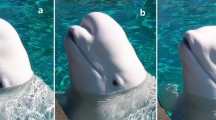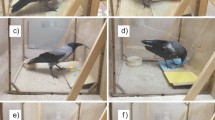Abstract
We examined aimed throwing as a means of food transfer in tufted capuchins (Cebus apella). We conducted this research in three phases. In Phase 1 we provided food to monkeys in one of two groups housed 1 m apart. We did not provide food to subjects in the second group. An observer recorded each instance in which a subject in the first group threw food toward one in the second group. In Phase 2 we provided a group of capuchins with food and noted each instance in which a subject threw food toward an empty cage. In Phase 3 we provided food simultaneously to two groups of capuchins and noted each instance of food-throwing between them. In Phase 1 subjects in one group threw food toward subjects in a second group, which, when provided the opportunity, did not throw food toward capuchins in the first group. Thrown food was either caught, retrieved, or lost on the test room floor. The rate of throwing decreased significantly when subjects were presented with an empty cage and when both groups of subjects were given food. We propose that psychological processes which underlie aimed throwing and food sharing came into existence through convergent evolution in large-brained, extractive foraging primates. We further speculate that although a well-developed system of exchange, based on contingent reciprocity, may occur among primates only inHomo,simpler transfer systems involving voluntary unidirectional passing of food from one individual to another appear to be more widespread among primates than previously thought and can be expressed in rather unusual circumstances such as those in this experiment.
Similar content being viewed by others
REFERENCES
Beck, B. B. (1980). Animal Tool Behavior. Garland STPM Press, New York.
Calvin, W. H. (1994). The emergence of intelligence. Sci. Am. 271: 101-107.
de Waal, F. B. M. (1989). Food sharing and reciprocal obligations in chimpanzees. J. Hum. Evol. 18: 433-459.
de Waal, F. B. M., Luttrell, L. M., and Canfield, M. E. (1993). Preliminary data on voluntary food sharing in brown capuchin monkeys. Am. J. Primatol. 29: 73-78.
Feistner, A. T. C., and Price, E. C. (1991). Food offering in New World primates: Two species added. Folia Primatol. 57: 165-168.
Goodall, J. (1986). The Chimpanzees of Gombe: Patterns of Behavior, Belknap Press of Harvard University Press, Cambridge, MA.
Hamilton, W., Buskirk, R., and Buskirk, W. (1975). Defensive stoning by baboons. Nature 256: 488-489.
Isaac, B. (1987). Throwing and human evolution. Afr. Archaeol. Rev. 5: 3-17.
Isaac, B. (1992). Throwing. In Jones, S., Martin, R., Pilbeam, D., and Bunney, S. (eds.), The Cambridge Encyclopedia of Human Evolution, Cambridge University Press, New York, p. 358.
Knüsel, C. J. (1992). The throwing hypothesis and hominid origins. Hum. Evol. 7: 1-7.
Kuroda, S. (1984). Interaction over food among pygmy chimpanzees. In Susman, R. (ed.), The Pygmy Chimpanzee, Plenum, New York, pp. 301-324.
Lee, R. B. (1979). The !Kung San, Cambridge University Press, Cambridge.
McGrew, W. C. (1992). Chimpanzee Material Culture: Implications for Human Evolution, Cambridge University Press, Cambridge.
Nissen, H., and Crawford, M. (1936). A preliminary study of food-sharing in young chimpanzees. J. Comp. Psychol. 22: 383-419.
Parker, S. T., and Gibson, K. R. (1977). Object manipulation, tool use and sensorimotor intelligence as feeding adaptations in Cebus monkeys and great apes. J. Hum. Evol. 6: 623-641.
Perry, S., and Rose, L. (1994). Begging and transfer of coati meat by white-faced capuchin monkeys, Cebus capucinus. Primates 35: 409-415.
Romanes, G. (1892). Animal Intelligence, Appleton, New York.
Schick, K. D., and Toth, N. (1993). Making Silent Stones Speak: Human Evolution and the Dawn of Technology, Simon and Schuster, New York.
Susman, R. L. (1994). Fossil evidence for early hominid tool use. Science 265: 1570-1573.
Tokida, E., Tanaka, I., Takefushi, H., and Hagiwara, T. (1994). Tool-using in Japanese macaques: Use of stones to obtain food from a pipe. Anim. Behav. 47: 1023-1030.
Westergaard, G. C., and Kuhn, H. E. (1997). Skeletal evidence for precision gripping in Cebus apella and its implications for the occurrence of tool-use among gracile australopithecines (submitted for publication).
Westergaard, G. C., and Suomi, S. J. (1994). Aimed throwing of stones by tufted capuchin monkeys (Cebus apella). Hum. Evol. 9: 323-329.
Westergaard, G. C., and Suomi, S. J. (1996). Stone-throwing by capuchins (Cebus apella): A model of throwing capabilities in Homo habilis. Folia Primatol. 65: 234-238.
Westergaard, G. C., and Suomi, S. J. (1997). Transfer of tools and food between groups of tufted capuchins (Cebus apella). Am. J. Primatol. 43: 33-41.
Author information
Authors and Affiliations
Rights and permissions
About this article
Cite this article
Westergaard, G.C., Kuhn, H.E., Babitz, M.A. et al. Aimed Throwing as a Means of Food Transfer Between Tufted Capuchins (Cebus apella). International Journal of Primatology 19, 123–131 (1998). https://doi.org/10.1023/A:1020315212310
Issue Date:
DOI: https://doi.org/10.1023/A:1020315212310




